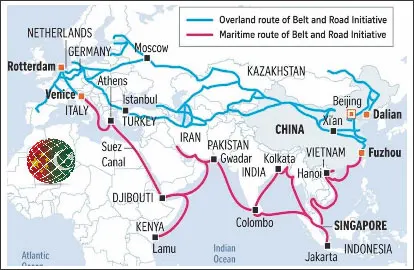China has been the biggest vocal of human rights in the world. It has a unique model of protection of human rights which it derives from immense socio-economic development, care of nature, community development and last but not the least shared development of the world.
The Chinese BRI and CPEC have already been instrumental for the eradication of poverty, generation of new jobs, community development and social transformation of improvised countries and communities around the world.
China had invested US$25.4 billion in direct projects in Pakistan, creating 236,000 jobs, generating 8,000 megawatts of electricity and building 510 kilometers of highways and 886 km of the national electricity grid.
It would rescue 1.1 million people from acute poverty by 2030, which bodes well even for the protection of human rights in the country. In this regard, BRI and CPEC have remained constructive, positive and productive, giving the message of hope of a brighter future through international cooperation, economic globalization, openness, inclusiveness, modernization and qualitative industrialization in all the member countries and the rest of the world.
Under the BRI 2.0 China will also implement 1,000 small livelihood assistance projects, promote vocational education cooperation between China and foreign countries and strengthen security guarantees for Belt and Road projects and personnel which is good omen for the development of SMEs in the member countries.
The 3rd BRI Forum for International Cooperation was commenced in Beijing, the participation of more than 140 countries and 30 international organizations vividly reflected the strategic importance of BRI in terms of socioe-conomic development and trans-regional connectivity with the member countries covering more than 75 percent of world population and a large proportion of its GDP.
It was carried out under the theme “High-quality Belt and Road Cooperation: Together for Common Development and Prosperity”, the forum, apart from the opening ceremony, consists of three high-level meetings for in-depth discussions on connectivity, green development and the digital economy and six thematic forums on trade connectivity, people-to-people relationship, exchanges among think tanks, green Silk Road, sub-national cooperation and maritime cooperation. It was a vivid reflection of even protection of human rights around the world through reduction of poverty levels and generation of new jobs and providing immense opportunities for all the member countries to achieve their desired goals of economic prosperity and human dignity. However, formation of Corridor of Knowledge may play a decisive role in terms of protection of human rights and reduction of poverty in all the member countries of the BRI.
The multibillion USD mega projects under CPEC are destined to usher in a new era of economic prosperity and peace in the country as well in the region. These mammoth projects in the energy sector, strengthening of physical and telecommunication networks, upgradation and strengthening of Gwadar port and establishment of Export Promotions Zones across Pakistan, are collectively called the “Destiny Changer” in the region. The dividends of the first early harvest phase of CPEC have already created trickle-down effects to the masses in Pakistan.
The academic and research collaboration between China and Pakistan have witnessed impressive growth in the last few decades in the areas of graduate studies, joint collaborative research, research funding, exchange programs, short term placement of students and faculty, organizing conferences, seminars and workshops etc.
There is an urgent need to have Corridor of Knowledge through conducting numerous research papers, qualitative articles about CPEC, BRI, foreign policy of China, socio-economic policies, bilateral relations, its concepts about befitting regionalism and friendly globalization, universal health policies, global humanitarian assistance and last but not the least, support to WHO and other international organizations for the betterment of humanity at large.
The objectives of the Corridor of Knowledge to establish collaboration amongst the CPEC Consortium Universities include study the geo-strategic and geo-economic dimensions of the Chinese Belt and Road initiative and CPEC to understand their long-term impact on Pakistan. It is meant to develop mechanisms to fully exploit the opportunities arising out of China’s appetite for global talent, and facilitate absorption of their graduates by the Pakistani economy. Thus the role of the CGSS & RIC is crucial and constant.
It supports higher education institutions (HEIs) in the development of human resources to implement the CPEC Long Term Plan. It develops the capacity of Pakistani universities for providing policy inputs to the government on the challenges emerging in the wake of implementation of CPEC Long Term Plan. Last but not least, it develops an understanding of Chinese history, culture and the governance system that has created the Chinese miracle, while drawing lessons for its own development.
The various components of the corridor of knowledge may include, joint research on climate adaptation, sustainable mountain development, food Security, urban planning, water resource management, supply chain management, IT, entrepreneurship, medicinal plants, gemstones and mineral resource management etc. It also includes talent cultivation and training, post-doctoral research, short-term training, dual degree programs between Chinese and Pakistani universities, conferences, seminars, workshops etc. In this regard, CGSS & RIC have comparative advantages over others which may be used.
In summary, BRI, CPEC have been supporting the uplifting of states, societies and systems around the globe. These projects have been frontline advocates of poverty reduction and generation of new jobs. These projects have been the hope of provision and protection of human rights and empowerment of humanity against all social ills and economic discrimination and disparities among the international communities.
views expressed are writer’s own.










